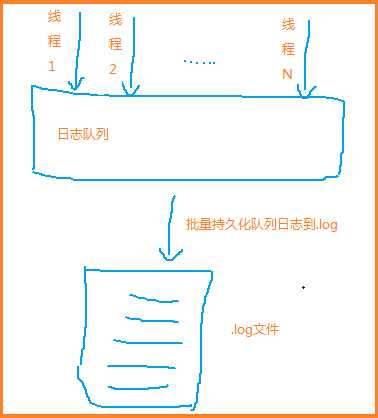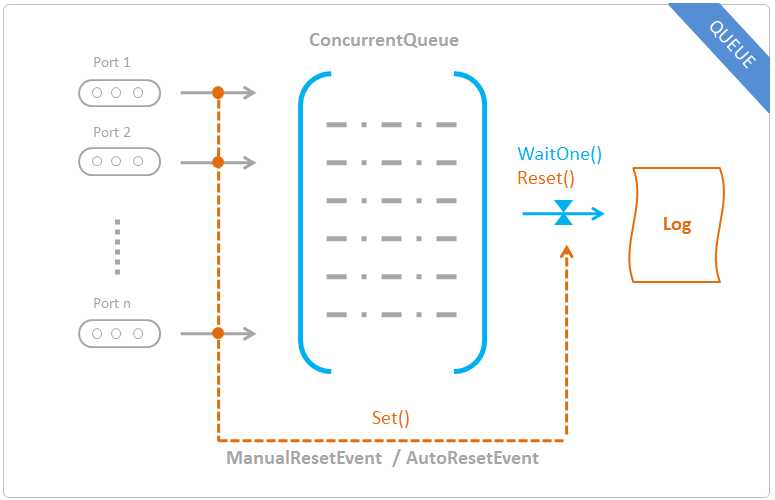标签:back enqueue run creat images 写入 count article item
一,简单问题复杂化:
100公里/1小时的速度,在日常生活中是比较常见的速度,把它转换为其它单位:
100公里/1小时 ≈ 28米/1秒
100公里/1小时 ≈ 2800厘米/秒
如果想要无人驾驶汽车达到厘米级的位移监测。探测器扫描路况时,每秒上传2800次数据给PC机。若一辆汽车有10个探测器,就意味着每秒的并发量为2.8W次/秒。
2.8W次/秒的并发量,在网站上肯定会采用分布式,缓存,读写分离,集群技术,关键还有这个数据的存储,到底用二维数据库,还是用NOSQL。这些问题是不是让你很头痛?
二,复杂问题简单化:
1个监测器对应1个线程,10个监测器对应10个线程。假设10个线程同时往数据库里写数据,显然不是一个明智的做法。
假设,开启一个Cache,10个线程同时往Cache里写数据。这儿要注意线程同步,内存溢出问题。
另外开启一个监控Cache的线程,这个线程主要三件事,1,监测Cache的数据变化,2,过虑Cache的冗余数据,3,持久化Cache数据到存储介质。用个示意图表示一下:

三,万物归一
百川归海,万物归一。看过我“100行代码实现了多线程,批量写入,文件分块的日志方法”这篇博客的园友。与我这个“C#版的无人驾驶汽车(附源码)”的 应用场景是不是十分相似?
两图对比,是不是对象都相同:


多个监测器上传数据 <--> 多个线程写日志
Cache <--> 日志对列
Cache监控线程 <--> 批量持久化日志线程
数据库垂直水平分库 <--> 日志分块
四,实践总结理论:
两篇博客的核心都只有一个,“多线程巧妙转换为单线程”,只是应用的场景不同。
一个应用于日志,一个应用于无人驾驶汽车。应用不同,本质相同,只要掌握了本质,万变不离其中。
在和企业谈工资的时候,要工资低些,可以说我会写日志的方法。
在和企业谈工资的时候,要工资高些,可以说做过C#版的无人驾驶汽车项目。
想低就低,想高就高,万物变化,大地沉浮,随心所欲。
五,源码实现:
其实这段源码,就是从上篇博客拷贝过来的,只是做了信号量的优化。方法名,类名一修改,可以应用到很多场景,万能的方法,万能的类。
public class IOExtention { static ConcurrentQueue<Tuple<string, string>> logQueue = new ConcurrentQueue<Tuple<string, string>>(); static Task writeTask = default(Task); static ManualResetEvent pause = new ManualResetEvent(false); //Mutex mmm = new Mutex(); static IOExtention() { writeTask = new Task((object obj) => { while (true) { pause.WaitOne(); pause.Reset(); List<string[]> temp = new List<string[]>(); foreach (var logItem in logQueue) { string logPath = logItem.Item1; string logMergeContent = String.Concat(logItem.Item2, Environment.NewLine, "-----------------------------------------------------------", Environment.NewLine); string[] logArr = temp.FirstOrDefault(d => d[0].Equals(logPath)); if (logArr != null) { logArr[1] = string.Concat(logArr[1], logMergeContent); } else { logArr = new string[] { logPath, logMergeContent }; temp.Add(logArr); } Tuple<string, string> val = default(Tuple<string, string>); logQueue.TryDequeue(out val); } foreach (string[] item in temp) { WriteText(item[0], item[1]); } } } , null , TaskCreationOptions.LongRunning); writeTask.Start(); } public static void WriteLog(String preFile, String infoData) { WriteLog(string.Empty, preFile, infoData); } public static void WriteLog(String customDirectory, String preFile, String infoData) { string logPath = GetLogPath(customDirectory, preFile); string logContent = String.Concat(DateTime.Now, " ", infoData); logQueue.Enqueue(new Tuple<string, string>(logPath, logContent)); pause.Set(); } private static string GetLogPath(String customDirectory, String preFile) { string newFilePath = string.Empty; String logDir = string.IsNullOrEmpty(customDirectory) ? Path.Combine(Environment.CurrentDirectory, "logs") : customDirectory; if (!Directory.Exists(logDir)) { Directory.CreateDirectory(logDir); } string extension = ".log"; string fileNameNotExt = String.Concat(preFile, DateTime.Now.ToString("yyyyMMdd")); String fileName = String.Concat(fileNameNotExt, extension); string fileNamePattern = string.Concat(fileNameNotExt, "(*)", extension); List<string> filePaths = Directory.GetFiles(logDir, fileNamePattern, SearchOption.TopDirectoryOnly).ToList(); if (filePaths.Count > 0) { int fileMaxLen = filePaths.Max(d => d.Length); string lastFilePath = filePaths.Where(d => d.Length == fileMaxLen).OrderByDescending(d => d).FirstOrDefault(); if (new FileInfo(lastFilePath).Length > 1 * 1024 * 1024 * 1024) { string no = new Regex(@"(?is)(?<=\()(.*)(?=\))").Match(Path.GetFileName(lastFilePath)).Value; int tempno = 0; bool parse = int.TryParse(no, out tempno); string formatno = String.Format("({0})", parse ? (tempno + 1) : tempno); string newFileName = String.Concat(fileNameNotExt, formatno, extension); newFilePath = Path.Combine(logDir, newFileName); } else { newFilePath = lastFilePath; } } else { string newFileName = String.Concat(fileNameNotExt, String.Format("({0})", 0), extension); newFilePath = Path.Combine(logDir, newFileName); } return newFilePath; } private static void WriteText(string logPath, string logContent) { try { if (!File.Exists(logPath)) { File.CreateText(logPath).Close(); } StreamWriter sw = File.AppendText(logPath); sw.Write(logContent); sw.Close(); } catch (Exception ex) { } finally { } } }
标签:back enqueue run creat images 写入 count article item
原文地址:http://www.cnblogs.com/xcj26/p/6100255.html